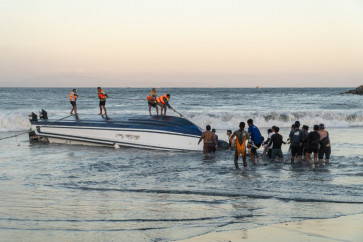Popular Reads
Top Results
Can't find what you're looking for?
View all search resultsPopular Reads
Top Results
Can't find what you're looking for?
View all search resultsAnalysis: The world is ‘on sale’
Wherever you go around the world, shop windows are screaming bargains at surprised shoppers everywhere
Change text size
Gift Premium Articles
to Anyone
W
herever you go around the world, shop windows are screaming bargains at surprised shoppers everywhere. In Australia, discounting has got to the point where consumers are wondering if this all too good to be true. In Melbourne, one of the most expensive cities in the world to live in, I have been buying things I never thought I really needed. Just because the price tags now aren’t just inviting, they are irresistible. This is worrying, on several levels.
If you think Jakarta is on sale too, and the other metros aren’t far behind on the discount wars, you need to see what’s going on outside Indonesia. Competition is always good for the consumer, but the price cuts are signs of something much more ominous. Around the world, nervous consumers are worrying about economic slowdowns and job losses. They are keeping their wallets closed, and retailers are trying to prise them open. Nervous businesses are cutting back on inventory and risk. The sluggish West is worrying an increasingly nervous East. Downward revisions in GDP are becoming routine. There are a few exceptions. Indonesia is one of those very few.
More than any other measurement, consumer sentiment is the leading indicator of economic In Indonesia, the KADIN-Roy Morgan Consumer Confidence index remains at record-breaking levels. Month after after month, it is hovering at the world-record breaking level of 150. But are they actually buying what they say they intend to, you may well ask. Is the purchase of consumer products holding steady? You will be pleased to know they are. In industry after industry, in category after category, the consumer economy continues to steam ahead. Global slowdown? Not here. Not yet, anyhow.
Let’s look at a few that serve as good examples of consumer confidence in action, not just word. Everyday essentials aren’t under threat, so we can focus on non-essentials to feel the pulse. In contrast with the spin put out by major operators in the space, new entrants continue to flood in to the telecommunications sector. The industry doesn’t have 200 million “customers” yet, simply because it isn’t possible in a country of 240 million: adults, children the aged and the poor. At the end of June 2012, there were 120 million people who had at least one SIM card. In the quarter ending Sept. 30, I believe another 3 million customers will join the community for the first time. And there are still more, waiting to come in. It’s useful to remember that there are some 160 million Indonesians 14 years of age and older. There’s room to grow in this demographically young country, the market isn’t saturated yet. The handset business is as robust as ever. Almost 15 million people bought at least one new mobile phone in the last 12 months. That number is likely to be even bigger in the next 12 months. Both purchase and intention to purchase are stronger than ever before.
Where there is a strong enough signal, most Indonesians watch television regularly. But if times were getting tougher, a new television set is perhaps the last thing a family would contemplate purchasing. Almost all TV sets bought in Indonesia today are replacement or additional sets in the household. Demand remains strong, across the country. Some 8 million people bought at least one new screen of one kind or another in the last 12 months. The number of people intending to buy one in the next 12 months stands at 8 million, stronger demand than
ever before.
Moving on, the refrigerator is doing just as well. Once a dream for many modest homes, it is quickly becoming an essential for Indonesia’s rapidly growing middle class. In the last 12 months, some 4 million people bought one for the first time or as a replacement. In the next 12 months, another 7 million are planning to give it pride of place in the home. Interestingly, in this product category, actual purchase is usually half of demand every year. But what is most reassuring are the facts that once again, actual purchase and future intentions remain as strong as ever.
The intention versus purchase ratio in the motorcycle industry is quite the opposite. That is because this is a big-ticket purchase. Till they know the money can become available, most people don’t think of buying. But a bonus, a windfall or even an approval of a loan can make an eager customer rush out to buy one. In the last 12 months, almost 9 million Indonesians bought at least one pair of wheels. In the next 12 months, as at June 30, another 2 million people would like to buy a motorcycle. In keeping with previous trends, the likely number of actual purchases in the next 12 months is likely to top 8 million again.
The consumer economy is in better shape than ever. The biggest single threat is the confidence of our captains of industry. If they are unduly influenced by the gloom around the globe, if they lose confidence in the Indonesian consumer, then the nightmare can become a reality. Let’s be careful what we wish for.
These opinions are influenced by Roy Morgan Single Source, the country’s largest syndicated survey. More than 26,000 respondents are interviewed every year, week after week. The data is projected to reflect 87 percent of the population 14 years of age and over.
The writer can be contacted at Debnath.Guharoy@roymorgan.com










